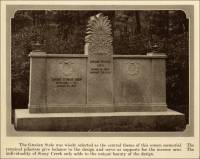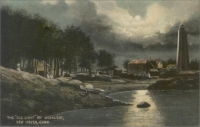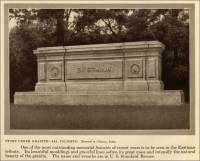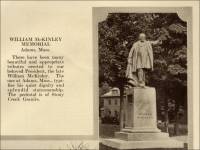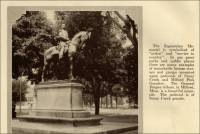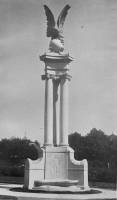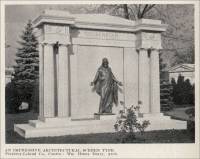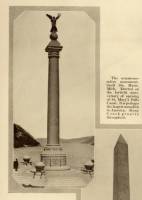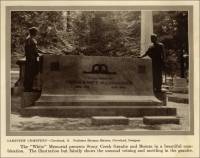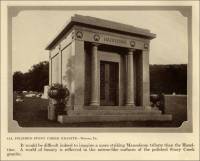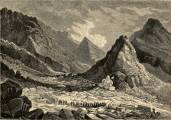
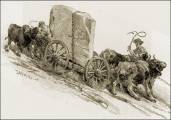

Structures and Monuments in Which Connecticut Stone was Used
- (unknown location) – the Edward Sturgis Crew & Robert Sturgis Crew Memorial / Stele (from Modern Memorial Art: Some Examples Cut in Stony Creek, Milford Pink and Victoria White Granites (PDF), The Dodds Granite Company, Main Office, Milford, Massachusetts, pp. 19) (Please contact me if you know of the location of the Crew memorial. Peggy B. Perazzo)
Stony Creek Granite quarried in Stony Creek, Connecticut, was used in the construction of the Crew memorial.
-
(unknown location) – the Haserot Memorial (from Modern Memorial Art: Some Examples Cut in Stony Creek, Milford Pink and Victoria White Granites (PDF), The Dodds Granite Company, Main Office, Milford, Massachusetts, pp. 19) (Please contact me if you know of the location of the Crew memorial. Peggy B. Perazzo)
Stony Creek Granite quarried in Stony Creek, Connecticut, was used in the construction of the Haserot memorial.
- Finished Products From Connecticut Stone Located
in California
- San Francisco, California - the James Flood Mansion & Surrounding Fence on Nob Hill at 1000 California Street (history and photographs) The following information was obtained from the City of Rocks web site by E. B. Keck. (This link is no longer available.)
< http://homepage.mac.com/ebandpck/cityrocks/mansion.html>
To view some of the damage caused to the James Flood Mansion by the 1906 San Francisco earthquake and fire, you can the photograph “Flood Bldg. Earthquake damage to stone piers,” presented on the America Hurrah web site by Bill Roddy.
James Flood’s 42-room mansion was constructed of brownstone (sandstone) quarried by the Middlesex Quarry Company in Portland, Connecticut. The stone was dressed in Newark, New Jersey and shipped “around the tip of South America to San Francisco.” The fence that surrounds the property was constructed of “bronze and thick slabs of Connecticut brownstone....” It is one of two Nob Hill structures that survived the San Francisco earthquake and fire in 1906.
- San Francisco, California - the James Flood Mansion & Surrounding Fence on Nob Hill at 1000 California Street (history and photographs) The following information was obtained from the City of Rocks web site by E. B. Keck. (This link is no longer available.)
- Finished Products From Connecticut Stone Located
in Connecticut
- Ansonia, Connecticut - the Fountain Hose Fire Co. Building (the trimmings). The Holbrook Quarry (granite), Seymour, New Haven County (From The Commercial Granites of New England, 1923)
- Blackwells Island, East River, Greenwich, Connecticut - Physician's Quarters; The Voorhis Quarry (granite), Greenwich township at the head of Byram Harbor, Connecticut. (granite) the physicians' quarters at the south end of Blackwells Island, East River. (From The Commercial Granites of New England, 1923)
- Bridgeport, Connecticut - Bridgeport Railway Station; The Burlison or Parsons Quarry (granite) (FromThe Commercial Granites of New England, 1923)
- Bridgeport, Connecticut - the Saratoga Monument, the interior, entrance and all but the upper 10 feet of the exterior; a polished inscribed tablet of the Millstone pink; base, pedestal, and cap of the Barnum Monument in Bridgeport; Millstone Quarry (granite), Waterford, New London County (FromThe Commercial Granites of New England, 1923)
- Bristol, Hartford County, Connecticut - "Brightwood," Mrs. W. A. McKay's Mansion. Mrs. W. A. McKay's mansion on West Street, in Bristol, was built of this granite, but some of it came from another now disused quarry, and some from the site of the mansion itself. The Dunn Quarry (granite), Bristol, Connecticut. (From The Commercial Granites of New England, 1923)
- Danbury, Connecticut - Great
Plain Cemetery - Gravestone made of Connecticut Valley
Sandstone (The link from which the following information was obtained is no longer available.)
<http://home.att.net/~gravestones/GPPHOTO.html>“A common problem with Connecticut Valley sandstone is the interior disintegration, with subsequent cracking and sloughing of the face.”
- East Lyme, New London County, Connecticut - Monuments; The Carlson Quarry (granite), East Lyme, New London County (From The Commercial Granites of New England, 1923)
- Farmington Canal Lock, Connecticut (history), by Herbert C. Darbee, Connecticut Historical Commission,
January 16, 1973. The walls of the canal lock were constructed with
red sandstone or brownstone which originated in central Connecticut. (The link from which this information was abstracted (see below)
does not appear to be working any longer.)
<http://borealis.lib.uconn.edu/archnet/topical/crm/conn/chc/farmcanl> - Greenwich, Connecticut - Catholic Church, the Bruce Memorial Gate (Bruce Park, Greenwich Avenue and Steamboat Road), and the residence of Charles Hirshhorn on North Street in Greenwich. The Christiano Oak Ridge Quarry (granite), Greenwich Township. (From The Commercial Granites of New England, 1923)
- Greenwich, Connecticut - Residences of George E. Weed of Rockside Park, and of James McCutcheon of Belle Haven Park; The Christiano Hamilton Avenue Quarry (granite) (From The Commercial Granites of New England, 1923)
- Groton, Connecticut - the Monument to Col. William Ledyard ("killed in battle of Groton Heights, 1781") in the Ledyard Cemetery; The Salter Quarry (granite), Groton, New London County (From The Commercial Granites of New England, 1923)
- Groton, Connecticut - Monuments; The McGaughey Quarry (granite), Groton, New London County (From The Commercial Granites of New England, 1923)
- Haddam Neck, Connecticut - the Gillette Quarry. "The Tourmaline Mine at Haddam Neck, Connecticut (Gillette Quarry)" by Martin, Daniel S. is an article found in an issue of the magazine, The Mineral Collector. This is one of the articles in the privately published Index to the Fifteen Volumes of The Mineral Collector, compiled and edited by John Betts. (The Mineral Collector was a magazine whose publication began in 1894 and continued for 15 years. The subjects of the magazine were minerals and mineral collecting.)
- Hartford, Connecticut - the Connecticut River Bridge. (the arches and coping) The Norcross Quarry (granite), Branford, New Haven County, Connecticut (From The Commercial Granites of New England, 1923)
- Hartford, Connecticut - Connecticut State Capitol Statuary Collection
-
Hartford, Connecticut – the “Fornlorn Soldier” Statue located at the Connecticut State Capitol. “The Forlorn Soldier,” by Anthony Roy, presented on the ConnecticutHistory.org (The article incluldes the complete history of the Forlorn Soldier statue and many photographs.)
The article begins: “The Forlorn Soldier is a brownstone statue created by James G. Batterson. For over a century the story of the statue was that people rejected it because the right foot was mistakenly thrust forward, which is opposite of the traditional parade-rest military pose….”
- Hartford, Connecticut - the Rossia Insurance Building; The Stony Creek Quarry (granite), Branford, New Haven County (From The Commercial Granites of New England, 1923)
- Hartford,
Connecticut - the Soldiers and Sailors Arch (photograph
and history)
According to this article, the Soldiers and Sailors Arch was constructed of brownstone from Portland, Connecticut.
- Hartford, Connecticut - the State-House. The following information is from Report of the United States National Museum Under the Direction of the Smithsonian Institutions For the Year Ending June 30, 1886, Chapter entitled, “The Collection of Building and Ornamental Stones In The U. S. National Museum: A Hand-book and Catalogue,” By George P. Merrill, Curator.
“…In the northern part of Litchfield County, near the Massachusetts line, in the town of Canaan, East Canaan, and Falls Village, there occur massive beds of a coarsely crystalline white dolomite, which have in years past furnished valuable building marbles, though recently they have been but little worked. The stone is said to weather well and to be obtainable in large blocks eminently suited for building, but like the Lee dolomite, it frequently contains crystals of white tremolite, which weather out on exposure. It is therefore not so well suited for finely finished or monumental work. The State-House at Hartford is the most important structure yet made from this material.”
- Litchfield, Connecticut - the L. Ripley residence; The Michiel Quarry, Torrington, Hartford County (From The Commercial Granites of New England, 1923)
- Meriden, Connecticut - the trimmings on the Litchfield library & on the State Armory; The Michiel Quarry (granite), Torrington, Hartford County (From The Commercial Granites of New England, 1923)
- Middletown, Connecticut - the Middletown Police Station (The following information was from Portland Brownstone Quarries (a division of Twin Oaks Enterprises, Inc.) (present-day company until July 2012), 311 Brownstone Avenue, Portland, Connecticut) According to this web site, “Portland Brownstone Quarries completed its 18 years of quarrying the Portland brownstone deposit as of January, 2012 and ceased fabricating the stone in July, 2012….” (The link from which the following information was obtained is no longer available.)
<http://www.brownstonequarry.com/pic4.htm>The Middletown police station was listed as one of the projects worked on by Portland Brownstone Quarries, according to the web site.
- Middletown, Connecticut - the Wesleyan University Buildings. From “The Collection of Building and Ornamental Stones In The U. S. National Museum: A Hand-book and Catalogue,” By George P. Merrill, Curator, Department Lithology and Physical Geology, in Report of the United States National Museum Under the Direction of the Smithsonian Institutions For the Year Ending June 30, 1886, pp. 516.
Brown sandstone from Portland, Connecticut, was used in the construction of the buildings.
- Naugatuck, Connecticut - the St. Francis Parochial School (the trimmings); the Holbrook Quarry (granite), Seymour, New Haven County (From The Commercial Granites of New England, 1923)
- New Haven, Connecticut - the First National Bank; the Stony Creek Quarry (granite), Branford, New Haven County (From The Commercial Granites of New England, 1923)
- New Haven Harbor, Connecticut - New Haven Light House at Lighthouse Point (photograph
and history)
"Also octagonal in shape, (a Connecticut lighthouse trademark) the exterior was constructed by Marcus Bassett. Made of sandstone from East Haven, furnished by Jabez Potter, the sandstone was hauled over difficult terrain by horse-draw drays. The interior was lined with New Haven brick. The circular staircase, with its 74 steps guiding the way to the lantern, are made of granite from local quarries."
-
New Haven, Connecticut – the present Light House – “The ‘Old Light’ by Moonlight, New Haven, Conn.” (colorized postcard photograph, No. 280; published by Danziger & Berman, New Haven CT.; early 1900s; unmailed)
Marcus Bassett constructed the exterior of the lighthouse from the sandstone quarry at East Haven, supplied by Jabez Potter. Locally quarried granite was used for the 74 steps. (Information and photographs of this lighthouse are available on the City of New Haven Department of Parks, Recreation, and Trees web site.)
- New London, Connecticut - the New London Ancient Burying Ground. (photographs and history)
This site is presented by "Roots
and Routes," the Heritage Travel Magazine, Lois Cunniff
Productions, Inc., Sunday, May 27, 2001. This article discusses the
book, The Colonial Burying Grounds of Eastern Connecticut and the
Men Who Made Them, first published in 1987, by James A Slater
and his findings. The following quote was taken from the cited article
above:
"A careful reading of early graveyards involves a knowledge of regional geology. Slater divides the 18th century gravestones east of the Connecticut River into four categories:
- Red and Brown Sandstones from the Connecticut River Valley
- Granite-schist "gray" stones from the inland heart of eastern Connecticut
- Slate stones from Boston and adjacent towns in eastern Massachusetts
- Slate stones from Newport, Rhode Island, and adjacent areas in the Narragansett River Basin
"Because of the town's wealth and location, 'New London's ancient burying ground is a bewildering mixture of Boston and Newport slates, Connecticut River valley sandstones, and inland granites.'"
- New London, Connecticut - the New London Cemetery - Connecticut Sandstone Gravestones - Antientest Burial Ground 1652 New London, Connecticut, The oldest graveyard in New London County and one of the oldest in New England, from the New London Gazette, published by The New London Gazette is published by The Oldham Publishing Service.
- Norfolk, Connecticut - Chapel of the Congregational Church, the Railroad Station, and the Egbert T. Butler and Anson Gaylor monuments in the Norfolk Center Cemetery; The Crissey Quarry (granite), Norfolk, Hartford County (From The Commercial Granites of New England, 1923)
- Norwich, Connecticut - the Chelsea Savings Bank; the Waterford Quarry (granite), Waterford, New London County (From The Commercial Granites of New England, 1923)
- Pawcatuck, Stonington Township, New London County, Connecticut - Monuments. The Murray Quarry (granite), in the village of Pawcatuck, in Stonington Township, New London County, The granite from the small opening was used for monuments. (From The Commercial Granites of New England, 1923)
- South Manchester, Connecticut (?) - Cheney Park (curbing and steps); the Brooks Quarry (granite), Glastonbury, Hartford County (From The Commercial Granites of New England, 1923)
- Stamford, Connecticut - Catholic Church; the Ritch Quarry (granite), Greenwich Township, Connecticut (From The Commercial Granites of New England, 1923)
- Stonington, Connecticut - the monument to the first four founders of Stonington at Wequetequock burying ground; the Salter Quarry (granite), Groton, New London County (From The Commercial Granites of New England, 1923)
- Thomaston, Hartford County, Connecticut - Monuments; the Plymouth Quarry (granite), Thomaston, Hartford County (From The Commercial Granites of New England, 1923)
- Torrington, Connecticut - the Italian Catholic Church; the Michiel Quarry (granite), Torrington, Hartford County (From The Commercial Granites of New England, 1923)
- Torrington, Connecticut - Parish house of the Third Congregational Church, the trimmings on factories of Standard Manufacturing Co. and the Union Hardware Co. - the Costello Quarry (granite), Torrington, Hartford County (From The Commercial Granites of New England, 1923)
- Windham, Connecticut – the Jillson House, now the headquarters for the Windham Historical Society (photograph and history) Gneiss granite quarried locally from the nearby Willimantic River was used in the construction of the building about 1924. Many of Willimantic's nineteenth century mills were also constructed of this gneiss granite.
- Windham, Connecticut – Mills in Willimantic (photograph and history) Gneiss granite quarried locally from the nearby Willimantic River was used in the construction of the building about 1924. Many of Willimantic's nineteenth century mills were also constructed of this gneiss granite.
- Windsor, Connecticut - Methodist Church (the trimmings) at Windsor; the Brooks Quarry (granite), Glastonbury, Hartford County (From The Commercial Granites of New England, 1923)
- Winsted, Connecticut - the Methodist Church; the Michiel Quarry (granite), Torrington, Hartford County (From The Commercial Granites of New England, 1923)
According to this article, the sandstone for the statue was quarried in Portland, Connecticut; and it was manufactured by Battersons Monument Works, located on Main Street.
-
Finished Products From Connecticut Stone Located in Illinois
- Chicago, Illinois - the Alexander Hamilton Memorialin Grant Park (sculptor was Bela Pratt); the Waterford Quarry (granite), Waterford, New London County (From The Commercial Granites of New England, 1923)
- Chicago, Illinois - the Newberry Library and Republic Monument; the Norcross Quarry (granite), Branford, New Haven County, Connecticut (From The Commercial Granites of New England, 1923)
- Chicago, Illinois - Palmer's Castle (photograph and history) Palmer's Castle was built for Potter Palmer. The exterior, completed in 1883, was constructed of Connecticut brownstone and Amherst stone from Ohio. The building was torn down in 1951.
- Finished Products From Connecticut Stone Located
in Iowa
- Clinton, Iowa – the Eastman Memorial (from Modern Memorial Art: Some Examples Cut in Stony Creek, Milford Pink and Victoria White Granites (PDF), The Dodds Granite Company, Main Office, Milford, Massachusetts, pp. 18)
Stony Creek Granite quarried in Stony Creek, Connecticut, was used in the construction of the Eastman memorial.
- Clinton, Iowa – the Eastman Memorial (from Modern Memorial Art: Some Examples Cut in Stony Creek, Milford Pink and Victoria White Granites (PDF), The Dodds Granite Company, Main Office, Milford, Massachusetts, pp. 18)
- Finished Products From Connecticut Stone Located
in Kentucky
- Hodgenville, Kentucky - Lincoln Memorial; the Norcross Quarry (granite), Branford, New Haven County, Connecticut (From The Commercial Granites of New England, 1923)
-
Finished Products From Connecticut Stone Located in Maine
- Portland, Maine - the Victoria Mansion, built by Ruggles S. Morse. (Scroll down to #9.) The mansion was constructed of Connecticut brownstone. The corner blocks are called quoins.
-
Finished Products From Connecticut Stone Located in Maryland
- Baltimore, Maryland - the Charles Tyler statue in Druid Hill Ridge Cemetery; the Salter Quarry (granite), Groton, New London County (From The Commercial Granites of New England,1923)
- Finished Products From Connecticut Stone Located
in Massachusetts
- Adams, Massachusetts – the President William McKinley Statue – the Pedestal (from Modern Memorial Art: Some Examples Cut in Stony Creek, Milford Pink and Victoria White Granites (PDF), The Dodds Granite Company, Main Office, Milford, Massachusetts, pp. 39)
Stony Creek Granite quarried in Stony Creek, Connecticut, was used for the pedestal of the President William McKinley statue.
- Boston to New York City - the Franklin
Mile Markers (The link from which the following information was obtained is no longer available.)
<http://www.samnet.net/esso/Fmm.htm>"In 1763, while deputy postmaster, Benjiman Franklin was assigned the task of placing a marker at one mile intervals along the Boston Post Road. The Boston Post Road was established as a permanent highway in 1639. It ran from Boston to New York City, at the time a distance of two hundred fifty four miles. These markers were made out of red Connecticut sandstone. Some of the material used also came from what is now East Longmeadow."
On kuklas.blogspot.com there is a short history and a photograph of one of the Franklin sandstone Mile Markers.
- Boston, Massachusetts - the Gibson House
Museum (a Back Bay Row House) (The web address from which this information was obtained is no longer available.)
<http://www.grisworld.com/GibsonHouse/virtualtour.html>The sandstone steps and first story of the house were constructed of Connecticut River Valley sandstone.
- Boston, Massachusetts - Harvard University - Harvard Hall (1766) (history) Lessons in Stone - Harvard's Building Blocks Teach Natural and Cultural History. (Harvard Magazine) Harvard Hall (1766, with additions in 1842 and 1870) - Brownstone (Sandstone used at as base course and the sandstone steps; from the Connecticut River valley)
- Boston, Massachusetts - Hooker Monument, statehouse grounds; the Norcross Quarry (granite), Branford, New Haven County, Connecticut (From The Commercial Granites of New England, 1923)
- Boston, Massachusetts - South Terminal Station at Boston; the Norcross Quarry (granite), Branford, New Haven County, Connecticut (From The Commercial Granites of New England, 1923)
- Cape Code, Barnstable County, Massachusetts - Old
Gravestones of Barnstable County, Massachusetts, 17th
and 18th Century Cape Code Gravestones, presented by Robert Carlson.
- The Barnstable - Marstons Mills Cemetery - Temperance Fish 1802. (photograph) "Sandstone markers generally were carved in Connecticut."
-
Malden, Massachusetts – Soldiers’ Monument – the Base, George T. Brewster, Sculptor, in The Monumental News, July 1895.
According to this article, “The monument stands complete, seventeen feet in height…The pedestal is composed of Stony Creek Granite, polished….” quarried in Stony Creek, Connecticut.
- Milford, Massachusetts – the General Draper Monument – the Base (from Modern Memorial Art: Some Examples Cut in Stony Creek, Milford Pink and Victoria White Granites (PDF), The Dodds Granite Company, Main Office, Milford, Massachusetts, pp. 38)
Stony Creek Granite quarried in Stony Creek, Connecticut, was used for the base of the General Draper monument.
- Quincy, Massachusetts - Monuments; the Malnati Quarry (granite), East Lyme, New London County (From The Commercial Granites of New England, 1923)
- Whitinsville, Massachusetts - are the Soldiers and Sailors' Monument; the Waterford Quarry (granite), Waterford, New London County (From The Commercial Granites of New England, 1923).

The Soldiers’ Monument, Malden (from the model), Massachusetts, George T. Brewster, Sculptor
(circa 1895)The caption reads: "The monument is of hammered buff-gray fine-grained quartz monzonite ("Connecticut white granite") from the Booth quarry at Waterford. A.D.F. Hamlin, architect; H. A. MacNeil, sculptor. Height to top of ball, 30 feet"
- Adams, Massachusetts – the President William McKinley Statue – the Pedestal (from Modern Memorial Art: Some Examples Cut in Stony Creek, Milford Pink and Victoria White Granites (PDF), The Dodds Granite Company, Main Office, Milford, Massachusetts, pp. 39)
- Finished Products From Connecticut Stone Located
in Michigan
- Locks Park, Saulte Ste. Marie, Michigan, on the American side - the Obelisk (45 feet long); The Norcross Quarry (granite), Branford, New Haven County, Connecticut (From The Commercial Granites of New England, 1923)
- Sault Ste. Marie, Michigan – the St. Mary’s Falls Canal Monument (from Modern Memorial Art: Some Examples Cut in Stony Creek, Milford Pink and Victoria White Granites (PDF), The Dodds Granite Company, Main Office, Milford, Massachusetts, pp. 40)
Stony Creek Granite quarried in Stony Creek, Connecticut, was used in the construction of the St. Mary’s Falls Canal commemorative monument.
- Finished Products From Connecticut Stone Located
in New Jersey
- Camp Merrit, New Jersey - the Camp Merrit Monument (photograph and history) Camp Merrit
was a large military camp in Bergen County, New Jersey, close to New
York Harbor during World War I. The first recruits arrived in 1917,
and the camp was decommissioned in 1919. The camp Merritt Monument
was dedicated in 1924 to honor those who had died. The monument is
a sixty-five-foot tall shaft made of Stony Creek Granite from New
Haven County, Connecticut. It was placed in a traffic circle in Cresskill
at the intersection of Knickerbocker Road and Madison Avenue by the
Harrison Granite Company, which built the monument. (If you would
like to view a photograph of the monument, choose the section entitled,
"Camp Merritt Photographs" located at the bottom on the web page.)
This information is presented in an article entitled, "Camp Merritt,"
by Kevin Wright, and the web site is presented by the Bergen County
Historical Society. (More historical information on Camp Merrit
is available in the article entitled, "Remembering
Camp Merrit," written by John Spring
Cresskill Historian and BCHS President 1983 - 86.)
- Camp Merrit, New Jersey - the Camp Merrit Monument (photograph and history) Camp Merrit
was a large military camp in Bergen County, New Jersey, close to New
York Harbor during World War I. The first recruits arrived in 1917,
and the camp was decommissioned in 1919. The camp Merritt Monument
was dedicated in 1924 to honor those who had died. The monument is
a sixty-five-foot tall shaft made of Stony Creek Granite from New
Haven County, Connecticut. It was placed in a traffic circle in Cresskill
at the intersection of Knickerbocker Road and Madison Avenue by the
Harrison Granite Company, which built the monument. (If you would
like to view a photograph of the monument, choose the section entitled,
"Camp Merritt Photographs" located at the bottom on the web page.)
This information is presented in an article entitled, "Camp Merritt,"
by Kevin Wright, and the web site is presented by the Bergen County
Historical Society. (More historical information on Camp Merrit
is available in the article entitled, "Remembering
Camp Merrit," written by John Spring
- Finished Products From Connecticut Stone Located
in New York
- Bronx, New York – Woodlawn Cemetery – the Gulbenkian Memorial (from “Types of the Year’s Best Cemetery Monuments: Many Distinctive Types: Development of Tablet and Cross Forms” (pdf), from The Monumental News, Vol. XXXIII, No. 1, January 1921, pp. 21.)
“The ‘Gulbenkian’ memorial is one of the notable works to be recently erected in Woodlawn Cemetery, New York. The grand scale of the massive Doric Screen is of itself an impressive architectural composition and in this instance the field of colorful Stony Creek Granite serves admirably to accentuate the appealing solitary figure of the Christ. This introduction of the Savior against a structure of pure pagan art might jar the sensibilities of those who fail to find a subtle symbolism suggested by the triumph of Christianity over paganism. Whatever motifs may have inspired the patron to thus blend two opposite themes, the fact remains that as an abstract composition in design the ensemble is admirable, impressive and stately. The figure of Christ was modeled by Philip Martiny, one of America’s celebrities in the field of sculpture. The work was designed by the Presbrey-Leland Company, of New York, and erected in Woodlawn Cemetery. The statue was cast by the Roman Bronze Works. The general dimensions are 18-6x5-0x12-6.”
- Bronx, New York – Woodlawn Cemetery – Woodlawn Cemetery – the Edward Newman Obelisk at Woodlawn Cemetery; the Salter Quarry (granite), Groton, New London County (From The Commercial Granites of New England, 1923)
- Bronx, New York – Woodlawn Cemetery – the Rathbone-Bacon Mausoleum (from Modern Memorial Art: Some Examples Cut in Stony Creek, Milford Pink and Victoria White Granites (PDF), The Dodds Granite Company, Main Office, Milford, Massachusetts, pp. 36)
Stony Creek Granite quarried in Stony Creek, Connecticut, was used in the construction of the Rathbone-Bacon mausoleum.
- Bronx, New York – Woodlawn Cemetery – the Stauffen Mausoleum (from Modern Memorial Art: Some Examples Cut in Stony Creek, Milford Pink and Victoria White Granites (PDF), The Dodds Granite Company, Main Office, Milford, Massachusetts, pp. 36)
Stony Creek Granite quarried in Stony Creek, Connecticut, was used in the construction of the Stauffen Mausoleum.
- Bronx, New York – Woodlawn Cemetery – the Stegman Mausoleum (from Modern Memorial Art: Some Examples Cut in Stony Creek, Milford Pink and Victoria White Granites (PDF), The Dodds Granite Company, Main Office, Milford, Massachusetts, pp. 35)
Stony Creek Granite quarried in Stony Creek, Connecticut, was used in the construction of the Stegeman mausoleum.
- Brooklyn, New York - Catholic Cathedral and Bishop House; the Ritch Quarry (granite), Greenwich Township, Connecticut - the Catholic cathedral and bishop house at the intersection of Vanderbilt, Lafayette, Clermont, and Green Avenues in Brooklyn, New York. (From The Commercial Granites of New England, 1923)
- Buffalo, New York - the Erie County Savings Bank in Buffalo; the Stony Creek Quarry (granite), Branford, New Haven County (From The Commercial Granites of New England, 1923)
- Flushing, New York - Catholic Church; the Ritch Quarry (granite), Greenwich Township, Connecticut (From The Commercial Granites of New England, 1923)
- Mamaroneck, New York - Catholic Church; the Ritch Quarry (granite), Greenwich Township, Connecticut (From The Commercial Granites of New England, 1923)
- Mamaroneck, New York - Residence of C. J. Osborn; the Voorhis Quarry (granite), Greenwich township at the head of Byram Harbor, Connecticut. (granite) (From The Commercial Granites of New England, 1923)
- Montauk, New York - Montauk
Point Light House (photograph and history) The light house
was constructed with Connecticut sandstone. This site is presented
by the Montauk Historical Society.
- Montauk Point Lighthouse, New York (photograph and history)
This site indicates that the sandstone came from Connecticut and
was shaped in Chatham, New York. (This link is no longer available.)
<http://community.webtv.net/%40Lookup
/myrascal/KEEPTHELIGHTS0/page3.html> - Montauk Point Lighthouse Museum (photograph and history)
- Montauk Point Lighthouse, New York (photograph and history)
This site indicates that the sandstone came from Connecticut and
was shaped in Chatham, New York. (This link is no longer available.)
- New York City, New York – Central Park – the General William T. Sherman Memorial – the Pedestal (from Modern Memorial Art: Some Examples Cut in Stony Creek, Milford Pink and Victoria White Granites (PDF), The Dodds Granite Company, Main Office, Milford, Massachusetts, pp. 38)
Stony Creek Granite quarried in Stony Creek, Connecticut, was used for the pedestal of the General William T. Sherman memorial.
- New York – the Clark residence over Riverside Drive – the basement, and the Dudley Celtic cross in Woodland Cemetery; The Waterford Quarry (granite), Waterford, New London County (From The Commercial Granites of New England, 1923)
- New York, New York - Cooper Union (The following information was from Portland Brownstone Quarries (a division of Twin Oaks Enterprises, Inc.) (present-day company until July 2012), 311 Brownstone Avenue, Portland, Connecticut) According to this web site, “Portland Brownstone Quarries completed its 18 years of quarrying the Portland brownstone deposit as of January, 2012 and ceased fabricating the stone in July, 2012….”
(The link from which the following information was obtained is no longer available.)
Cooper Union was listed as one of the projects worked on by Portland Brownstone Quarries, according to the web site.
- New York - the Grand Central Terminal Station, Bellevue Hospital, Kent Hall and the Philosophy Building at Columbia University; the Lord & Taylor Building in New York; The Stony Creek Quarry (granite), Branford, New Haven County (From The Commercial Granites of New England, 1923)
- New York City -The four rock-faced houses on the corner of 72nd Street and 10th Avenue, and the retaining wall of the New York Central and Hudson River Railroad at 67th to 72nd Streets in New York. The Rockside Quarry (granite), Roxbury, Hartford County (From The Commercial Granites of New England, 1923)
- New York - Sheridan Monument – the pedestals; the Norcross Quarry (granite), Branford, New Haven County, Connecticut (From The Commercial Granites of New England, 1923)
- New York City - Wall of Trinity Cemetery; the Voorhis Quarry (granite), Greenwich township at the head of Byram Harbor, Connecticut. (granite) the wall about the Trinity Cemetery at 153rd Street and Broadway in New York City. (From The Commercial Granites of New England, 1923)
- Port Washington, Long Island - Episcopal Church; the Voorhis Quarry (granite), Greenwich township at the head of Byram Harbor, Connecticut. (granite) (From The Commercial Granites of New England, 1923)
- Sag Harbor, New York - Old Burying Ground, by Lois Beachy Underhill. Sandstone was transported from Connected to be used as cemetery gravestones.
- Southold, New York - The Old Burial
Ground, by Peter Venturini. Sandstone from Connecticut
was transported for use as cemetery gravestones in the Old Burial
Ground. (The link from which this information was obtained is no longer available.)
<http://mason.gmu.edu/~pventuri/gravestn.html> - Throgs Neck, Long Island Sound, New York - Fort Schuyler; the Voorhis Quarry (granite), Greenwich township at the head of Byram Harbor, Connecticut. (granite) (From The Commercial Granites of New England, 1923)
- Valhalla, New York - the Kennard Celtic Cross at the Kensico Cemetery; the Salter Quarry (granite), Groton, New London County (From The Commercial Granites of New England, 1923)
- West Point, New York - the Battle Monument (the polished columns) (43 feet by 6 feet 2 inches at base); the Norcross Quarry (granite), Branford, New Haven County, Connecticut (From The Commercial Granites of New England, 1923)
- West Point, New York – the Battle Memorial (from Modern Memorial Art: Some Examples Cut in Stony Creek, Milford Pink and Victoria White Granites (PDF), The Dodds Granite Company, Main Office, Milford, Massachusetts, pp. 40)
Stony Creek Granite quarried in Stony Creek, Connecticut, was used in the construction of the shaft of the battle monument at West Point. Milford Pink Granite quarried at Milford, Massachusetts, was used for the rest of the memorial.
- Bronx, New York – Woodlawn Cemetery – the Gulbenkian Memorial (from “Types of the Year’s Best Cemetery Monuments: Many Distinctive Types: Development of Tablet and Cross Forms” (pdf), from The Monumental News, Vol. XXXIII, No. 1, January 1921, pp. 21.)
- Finished Products From Connecticut Stone Located
in Ohio
- Cleveland, Ohio - the Guardian Trust & Savings Building; the Stony Creek Quarry(granite), Branford, New Haven County (From The Commercial Granites of New England, 1923)
- Cleveland, Ohio - the Key Tower (formerly known
as the Society Tower) in Downtown Cleveland
(constructed in 1990-1991) Stony Creek granite (quarried in Connecticut), is used to face most of the building. For the lower two floors of the building Napoleon Red granite (from Vanga, Sweden) is used. Rosso Verona marble (Red Verona) is used inside the Key Tower and the adjacent hotel complex. This marble is an orange-colored limestone which is quarried in the Venice, Italy, area. (From Guide to the Building Stones of Downtown Cleveland: A walking tour in celebration of Earth Science Week 2000, by J. T. Hannibal and M. T. Schmidt, Ohio Geological Survey Guidebook No. 5, 33 p., 1992, [Reprinted, 1994.] Building Stones in the Vicinity of Public Square, Cleveland, Ohio, a brochure based on the guidebook, was published in 2000 and is available online.)
- Cleveland, Ohio – Lakeview Cemetery – the Thomas H. & Almira L. White Memorial (from Modern Memorial Art: Some Examples Cut in Stony Creek, Milford Pink and Victoria White Granites (PDF), The Dodds Granite Company, Main Office, Milford, Massachusetts, pp. 10)
Stony Creek Granite quarried in Stony Creek, Connecticut, was used in the construction of the White memorial.
- Xenia, Ohio – Woodland Cemetery – the Charles Lewis Babb Memorial (from Modern Memorial Art: Some Examples Cut in Stony Creek, Milford Pink and Victoria White Granites (PDF), The Dodds Granite Company, Main Office, Milford, Massachusetts, pp. 10)
Stony Creek Granite quarried in Stony Creek, Connecticut, was used in the construction of the Babb memorial.
- Finished Products From Connecticut Stone Located
in Pennsylvania
- Johnstown, Pennsylvania – the Coolidge Memorial (from Modern Memorial Art: Some Examples Cut in Stony Creek, Milford Pink and Victoria White Granites (PDF), The Dodds Granite Company, Main Office, Milford, Massachusetts, pp. 18)
Stony Creek Granite quarried in Stony Creek, Connecticut, was used in the construction of the Coolidge Memorial.
- Pittsburgh, Pennsylvania - the Bessemer Building; the Norcross Quarry (granite), Branford, New Haven County, Connecticut (From The Commercial Granites of New England, 1923)
- Pittsburgh, Pennsylvania - the Dollar Savings Bank (photographs and history) The bank was constructed of Connecticut Brownstone.
- Philadelphia, Pennsylvania - the George W. Childs Mausoleum; Millstone Quarry(granite), Waterford, New London County (From The Commercial Granites of New England, 1923)
- Philadelphia, Pennsylvania - the Hoy Mausoleum in the Mount Moriah Cemetery; the Waterford Quarry (granite), Waterford, New London County (From The Commercial Granites of New England, 1923)
- Philadelphia, Pennsylvania - the Rev. Byron A. Woods Sarcophagus in Forest Hill Cemetery; the Salter Quarry (granite), Groton, New London County (From The Commercial Granites of New England, 1923)
- Pittsburgh, Pennsylvania - the City Deposit Bank; the Waterford Quarry (granite), Waterford, New London County (From The Commercial Granites of New England, 1923)
- Warren, Pennsylvania – the Hazeltine Mausoleum (from Modern Memorial Art: Some Examples Cut in Stony Creek, Milford Pink and Victoria White Granites (PDF), The Dodds Granite Company, Main Office, Milford, Massachusetts, pp. 34)
Stony Creek Granite quarried in Stony Creek, Connecticut, was used in the construction of the Hazeltine mausoleum.
- Johnstown, Pennsylvania – the Coolidge Memorial (from Modern Memorial Art: Some Examples Cut in Stony Creek, Milford Pink and Victoria White Granites (PDF), The Dodds Granite Company, Main Office, Milford, Massachusetts, pp. 18)
- Finished Products From Connecticut Stone Located
in Rhode Island
- Newport, Rhode Island - the Channing Memorial Church and Steeple, built in 1881; The MacCurdy Quarry (granite), Old Lyme, New London County (From The Commercial Granites of New England, 1923)
- Newport, Rhode Island - St. Mary’s Church (The following information was from Portland Brownstone Quarries (a division of Twin Oaks Enterprises, Inc.) (present-day company until July 2012), 311 Brownstone Avenue, Portland, Connecticut) According to this web site, “Portland Brownstone Quarries completed its 18 years of quarrying the Portland brownstone deposit as of January, 2012 and ceased fabricating the stone in July, 2012….”
The St. Mary’s Church was listed as one of the projects worked on by Portland Brownstone Quarries, according to the web site.
- Providence, Rhode Island - the Littlefield shaft at Swan Point Cemetery; the Waterford Quarry (granite), Waterford, New London County (From The Commercial Granites of New England, 1923)
- Finished Products From Connecticut Stone Located in South Carolina
- Charleston, South Carolina - Cathedral of St. John the Baptist
(1890-1907) (history) The first Cathedral of St. John the Baptist
was constructed of built of Connecticut sandstone. The building was
lost in a fire in 1861. It was replaced and the newer building was
constructed of Connecticut brownstone. (This link is no longer
available.)
<http://www.insiders.com/charleston-sc/main-attractions3.htm>
- Charleston, South Carolina - Cathedral of St. John the Baptist
(1890-1907) (history) The first Cathedral of St. John the Baptist
was constructed of built of Connecticut sandstone. The building was
lost in a fire in 1861. It was replaced and the newer building was
constructed of Connecticut brownstone. (This link is no longer
available.)
- Finished Products From Connecticut Stone Located
in Virginia
- Winchester, Virginia - National Cemetery - the Monument Erected by the Eighteenth Connecticut Regiment. The following information is from The Monumental News, “Trades Notes” section, August, 1895, Vol. 7, No. 8, Chicago, Illinois, pp. 502.
“The New England Granite Co., Hartford, Conn., have the contract for the monument to be erected by the Eighteenth Connecticut regiment in the National cemetery at Winchester, Va. The monument will be made of Concord granite and will consist of a base, die and a shaft, the latter rock faced with hammered margin lines. Total height 13’ 1”.”
- Winchester, Virginia - National Cemetery - the Monument Erected by the Eighteenth Connecticut Regiment. The following information is from The Monumental News, “Trades Notes” section, August, 1895, Vol. 7, No. 8, Chicago, Illinois, pp. 502.
- Finished Products From Connecticut Stone Located
in Washington, D. C.
- Washington, D. C. - the Baron von Steuben Monument; the Stony Creek Quarry (granite), Branford, New Haven County (From The Commercial Granites of New England, 1923)
- Washington, D. C - the Commerce Department Building (photograph) The exterior and first and second floors were built using Stony Creek granite from Stony Creek, New Haven County, Connecticut. (coarse-grained granite, with large pink feldspar crystals in a gray mass of smaller crystals)
- Washington, D.C. - Gallaudet University Building (The following information was from Portland Brownstone Quarries (a division of Twin Oaks Enterprises, Inc.) (present-day company until July 2012), 311 Brownstone Avenue, Portland, Connecticut) According to this web site, “Portland Brownstone Quarries completed its 18 years of quarrying the Portland brownstone deposit as of January, 2012 and ceased fabricating the stone in July, 2012….” (The link from which the following information was obtained is no longer available.)
<http://www.brownstonequarry.com/pic1.htm>A building at Gallaudet University was listed as one of the projects worked on by Portland Brownstone Quarries, according to the web site.
- Washington, D. C. - the General Staff College; the Norcross Quarry (granite), Branford, New Haven County, Connecticut (From The Commercial Granites of New England, 1923)
- Finished Products From Connecticut Stone in
Canada
- Hamilton, Ontario, Canada -Bank of Hamilton (photograph and history), presented by the Hamilton Public Library. (The Hamilton Library link from which this information was obtained is apparently not available on the web site at this time. Contact the library for further information on this building.) < http://www.hpl.ca/Collections/downtown/Bnkham.htm>
Construction Materials: Connecticut brown stone
- Hamilton, Ontario, Canada -
Birks Building (photograph and history), presented by the Hamilton Public Library. (The Hamilton Library link from which this information was obtained is apparently not available on the web site at this time. Contact the library for further information on this building.) < http://www.hpl.ca/Collections/downtown/Birks.shtml>
Construction Materials: Connecticut brown stone
- Hamilton, Ontario, Canada -
Canada Life Assurance Company (photograph and history), presented by the Hamilton Public Library. (The Hamilton Library link from which this information was obtained is apparently not available on the web site at this time. Contact the library for further information on this building.)
<http://www.hpl.ca/Collections/downtown/canadalife.shtml>Construction Materials: Connecticut brown stone
- Hamilton, Ontario -
Hamilton Spectator (photograph and history), presented by the Hamilton Public Library. (The Hamilton Library link from which this information was obtained is apparently not available on the web site at this time. Contact the library for further information on this building.) < http://www.hpl.ca/Collections/downtown/Spec.shtml>
Construction Materials: Rubbed Connecticut brown stone and manganese pressed brick
- Hamilton, Ontario, Canada -Bank of Hamilton (photograph and history), presented by the Hamilton Public Library. (The Hamilton Library link from which this information was obtained is apparently not available on the web site at this time. Contact the library for further information on this building.) < http://www.hpl.ca/Collections/downtown/Bnkham.htm>
Commercial use of material within this site is strictly prohibited. It is not to be captured, reworked, and placed inside another web site ©. All rights reserved. Peggy B. and George (Pat) Perazzo.
